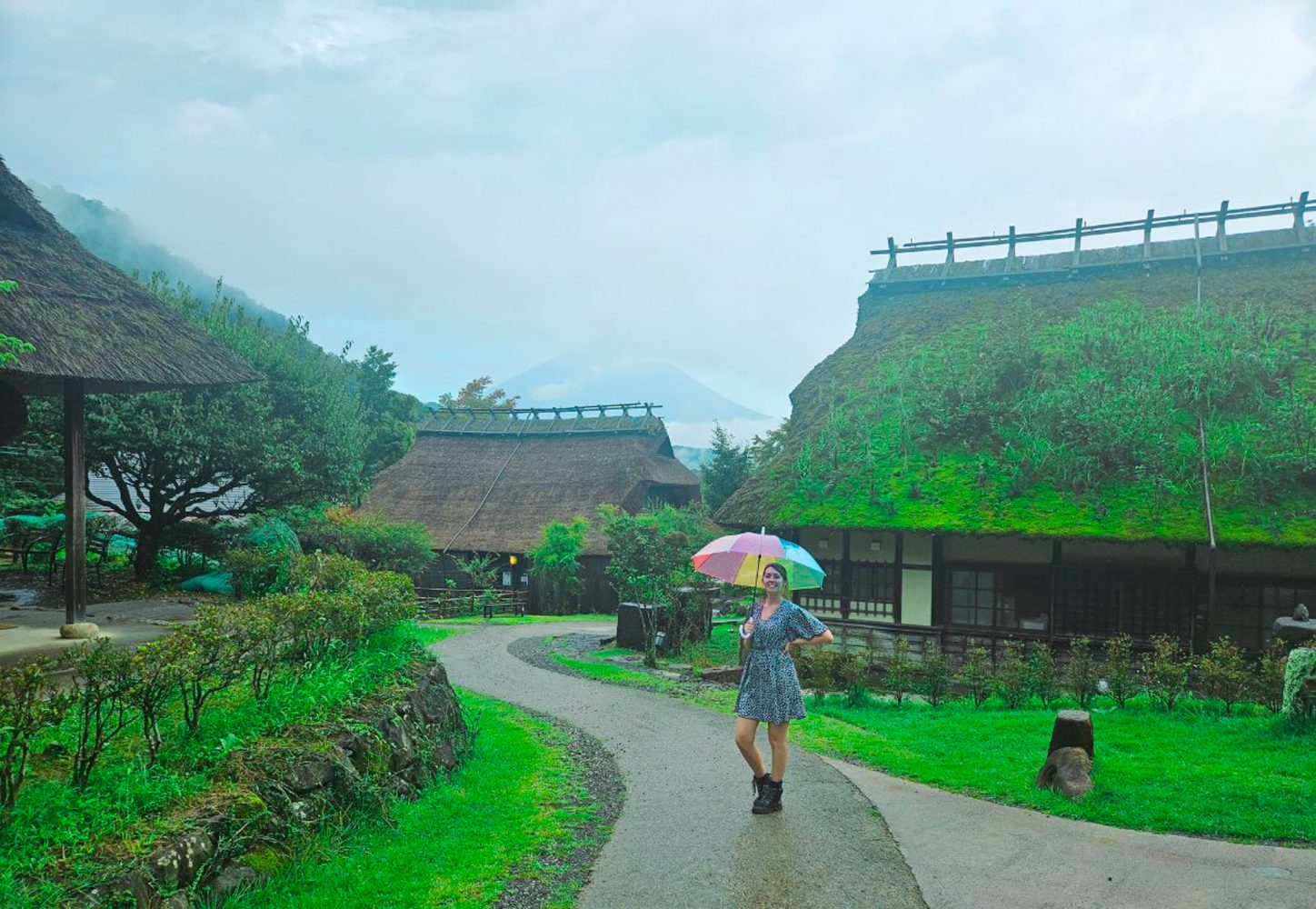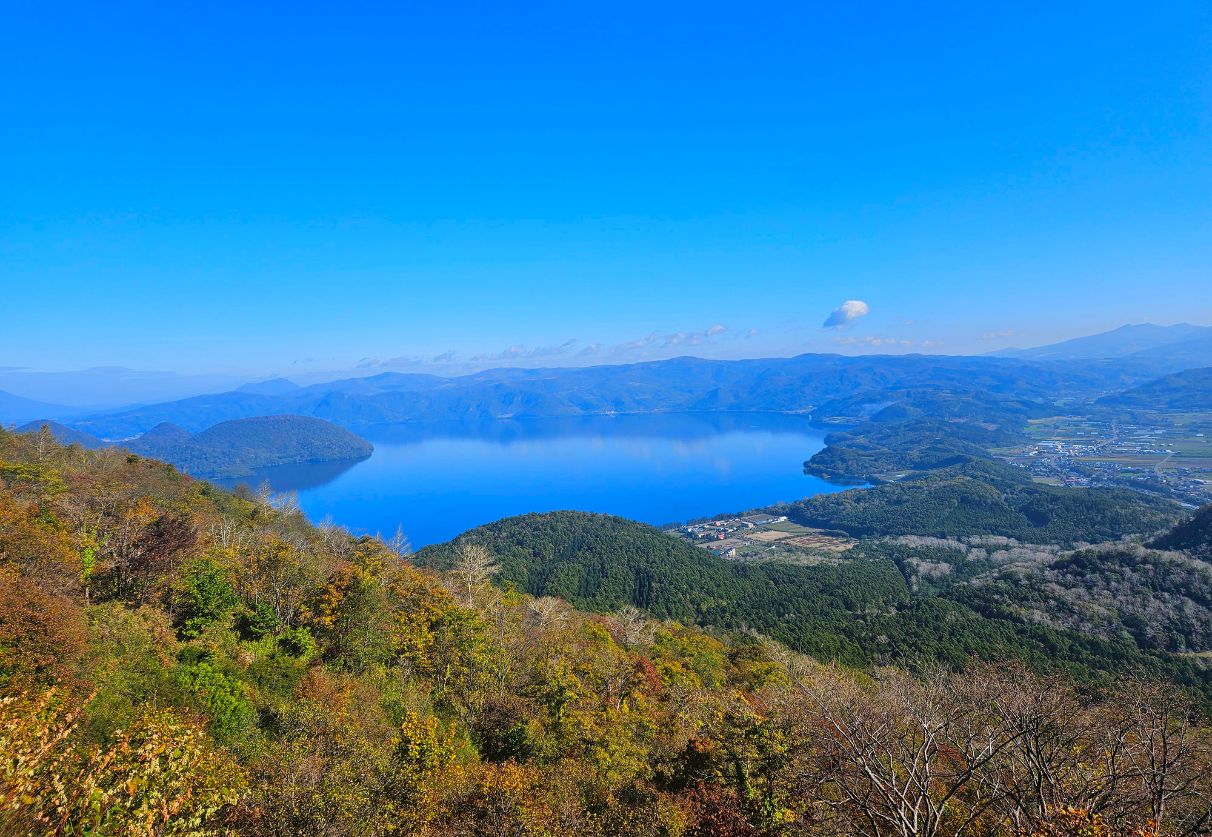Saiko Iyashi no Sato Nemba: Traditional Village in Japan
Some links in this post are affiliate links. This means if you purchase something through my links I may make a small commission at no extra charge to you. See my disclaimer.
Saiko Iyashi-no-Sato Nemba (sometimes spelt Nenba) is a traditional folk village located in the Yamanashi Prefecture. It’s an adorable little village consisting of multiple cottages with tall, slanted thatched roofs which easily allow snow to slide off, in turn keeping the houses warmer and drier during winter.
This traditional settlement has not always been in this location, as the houses were instead relocated from other similar villages as a way of learning about and protecting them for future generations.
Each of the wooden properties allows you a glimpse into the past and offers stunning views over the valley and, on a clear day, the breathtaking Mt.Fuji.
So, before you travel into the rural region, let’s find out what all the fuss is about so you know what to expect when you visit.
| Country: | Japan |
| Currency: | Japanese Yen / JPY |
| Do you need a visa to visit as tourists? | Check here |
Don’t forget to get travel insurance to cover you if something bad happens. One company I have personal experience with is Safety Wing. Not everyone needs the same coverage, so make sure you get a personalised quote that suits you and your trip plans.
Check out our hub Pages for your upcoming Japan trip:
Japan Working Holiday Hub
Working Holiday Visa Hub
Gap Year Planning Hub

How to get to Saiko iyashi no sato nemba
Location: 〒401-0332 Yamanashi, Minamitsuru District, Fujikawaguchiko, Saiko, 根場 2710
If you are travelling independently by car, you’ll be pleased to know there is a car park available free of charge.
I’d also recommend ordering your eSIM by Airalo in advance so you can navigate easily and stay connected during your stay.
Most tourists to Japan visit this village from Tokyo. If you were to join a guided tour (more on this below), you would simply meet the tour guide and they’d drive you there, giving you one less thing to worry about. If instead you choose to travel yourself,f you’d likely need to rent a car. When driving, you can expect it to take:
- 2 hours by car from Shinjuku, Tokyo
- 2 hours 15 by car from Shibuya, Tokyo
If travelling from other large cities, the following times can be expected:
- 1 hour 40 by car from Shizuoka
- 2 hours 50 by car from Nagano
- 3 hours 20 by car from Nagoya
If you need to rent a car, you can use the following rental companies, as I have used all three throughout my time living in Japan with good experiences. Rental Cars / Klook Car Rental. Please also remember your International Driving Permit!
If you’re unable to drive and instead want to take public transport, (I really wouldn’t recommend this as it’s complicated, time-consuming and if you don’t time things right you could get stranded) but on average from Tokyo could take between 2 hours 40 and 3 hours 40 depending on the time of day and the public transportation route you choose.
Google Maps is a great app to use as times and schedules are accurate across Japan.
Inspired to visit other traditional Japanese villages during your stay in Japan? Check these out:
- Tsumago juku: Japan’s best-preserved postal town from the Edo period
- Gero Onsen Gassho Village: A rural village from the past
- Hida no Sato: A mesmerising traditional village in Gifu Japan
- Shirakawa go
- Kayabuki No Sato: thatched-roof traditional village
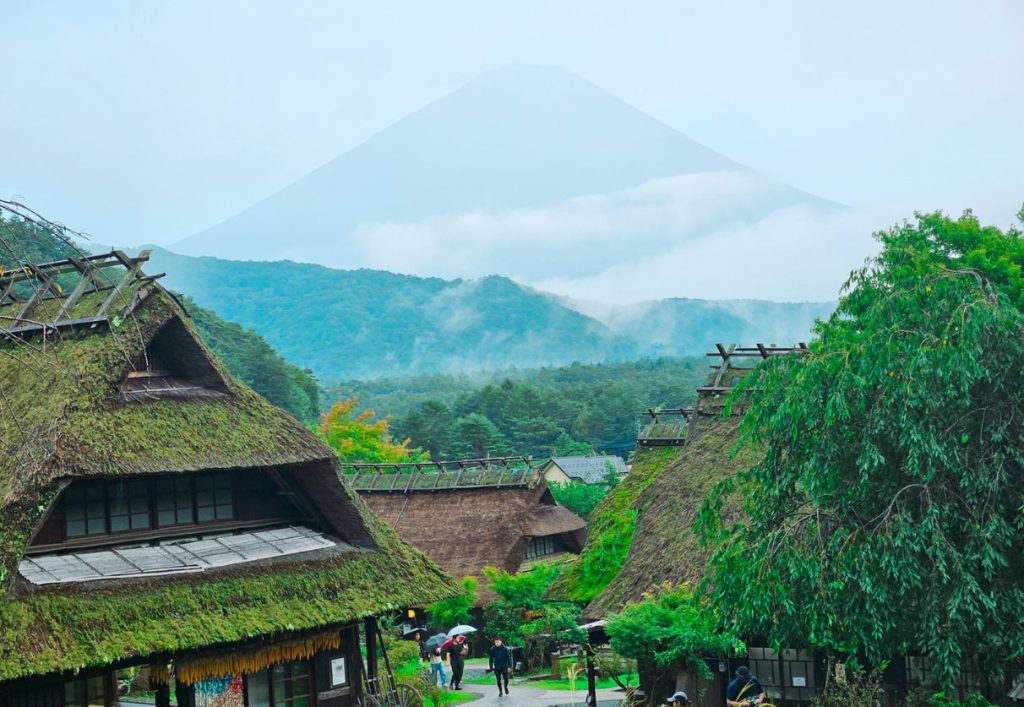
Guided tours to Saiko Iyashi no Sato Nemba
If you’d like to visit this village but you’re not comfortable driving or travelling independently, you have the option to join a guided group tour, which includes transport to and from the village. Both of the recommended tours below depart from Tokyo, which makes it easy to meet the tour guide!
These tours can be booked up quite quickly, so I’d recommend booking as early as you can when you decide you want to visit Saiko Iyashi no Sato Nemba.
Mount Fuji & Lake Kawaguchi Scenic 1-Day Bus Tour – departs from TOKYO
This tour visits Arakurayama Sengen Park to see the famous pagoda with mesmerising views of Mt.Fuji, Lake Kawaguchi and Oishi Park and the flower fields surrounding it, before heading to Saiko Iyashi-no-Sato Nemba to dive into the history of Japan’s past.
Scenic Spots of Mount Fuji Full Day Bus tour – departs from TOKYO
This tour visits Saiko Iyashi no Sato Nemba village first before moving on to other famous Fuji viewing spots. Lake Kawaguchiko is next, followed by Oishi Park, Kawaguchiko Natural Living Center, Arakurayama Sengen Park, Arakura Fuji Sengen Shrine and lastly Oshino Hakkai.

What to expect at the Saiko Iyashi no Sato Nemba village
Although some of the huts accepted card, the vast majority required cash for payment.
If you need to transfer or take out cash in Japan at a lower rate, consider using Wise. I’ve used them since 2015, and they allow cheap international transfers and even their own foreign currency bank account to make moving money easier for your trips.
When you arrive at Saiko Iyashi no Sato Nemba, you’ll notice it is almost completely surrounded by mountains, which create a picturesque photo opportunity from almost every angle.
The car park is a few minutes walk from the entrance, and the village consists of 22 old-fashioned wooden buildings that have been restored in this destination as part of an open-air museum.
Each building offers something different, and you can check them all out while learning about traditional crafts and practices from Japan’s past.
Below is a list of each of the buildings found on the grounds:
Food & Snacks in Saiko Iyashi no Sato Nemba
#1 – Seiryutei
This is a tea house where you can enjoy matcha, sweet rice dumplings known as dango, and some other handmade candies and sweets. You can do all of this while enjoying a calming Japanese tea while sitting on a classic tatami floor.
#20 – Restaurant Satoyama
In this restaurant, you can try a few different loved dishes made by locals, which allows you to really appreciate the various flavours from the Yamanashi Prefecture. Here you can taste miso-based soup named Hoto, and even the much-loved udon that is eaten across Japan.
#21 – Handmade Soba Mizumo
As the name suggests, this is a popular lunch spot where you can enjoy handmade soba dishes while taking in the calming atmosphere of the village.
Stores & Souvenirs
#4 – Speciality Products Store
This is a store where you can purchase a wide range of products made locally in the Yamanashi prefecture. You’ll be able to purchase some souvenirs and small decor-type items for your home, as well as some snacks like ice cream and a local rice drink.
#19 – Omoideya
In the 19th hut of Saiko Iyashi no Sato Nemba, you’ll get to purchase all of your Mt. Fuji-related items, ranging from glass ornaments, pictures, toys for children and just general knick-knacks adorned with Fuji decorations and images.
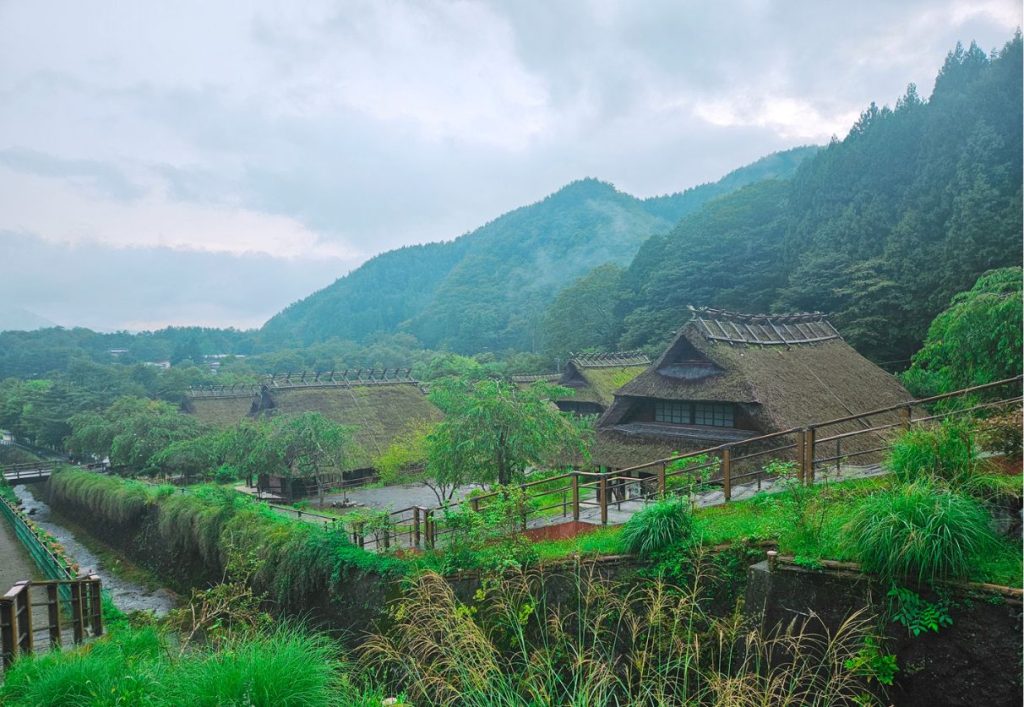
Village Rest Areas, Viewpoints & Miscellaneous
#2 – Water Mill Hut
This is simply a water mill that doesn’t typically allow visitors inside. However, it does offer one of the most photographed huts from the outside due to the old spinning water wheel.
#3 – General Information Center
The general information centre here at Saiko Iyashi no Sato Nemba is here to help visitors and to assist anyone who may need assistance with getting around, such as loaning out wheelchairs, directing people to the correct places and providing any other information necessary for a visit.
#5 – Kutsurogiya (Rest Area)
This is an indoor area that allows you to relax on a wooden floor and take a break from exploring or to shelter from the weather outside.
#15 – Rest area and public toilets.
This is another rest area that also has restrooms available.
#9 – Goronekan (view point)
The Goronekan is another rest area, except this one is at the top of the hill in the village and offers the best view of Fuji and Saiko Iyashi no Sato Nemba in all its glory.
#10 – Takumiya (view point)
This is one of the smaller relaxation rooms where you can both enjoy another stunning view of the village, but also admire some artworks. If you like the art enough, you can even purchase one as a souvenir!
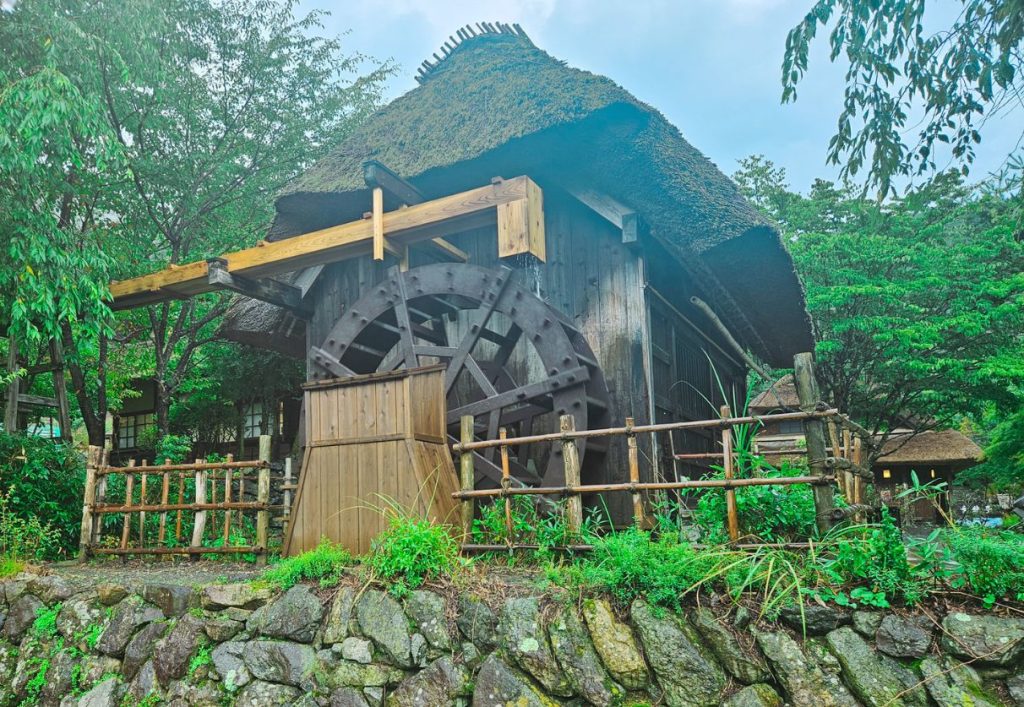
Museums & Exhibits
#6 – Seseragiya
The Seseragiya is home to museum exhibits relating to the typical lifestyle of Japanese farmers from the past and the modern age. Visitors can learn all about this lifestyle through photos, postcards and even some live demonstrations from staff based in the village. You’ll get to see a wide range of traditional farming equipment here.
#7 – Sabo (Erosion Control) Museum
This museum teaches visitors all about the sediment disaster and offers tips on how to avoid the same thing happening in future. Using images, audio clips and videos, they teach preventative measures for future disasters, which is especially useful given the landscape of Japan.
#11 – Miharashiya
This is a museum with art exhibits. Occasionally, the exhibit is changed and updated, but at the time of writing, the artist by the name of Kosei Maeda has their artwork displayed. This artist is a manga illustrator who directs Japanese Folk Tales using animations and traditional cartoon-style drawings.
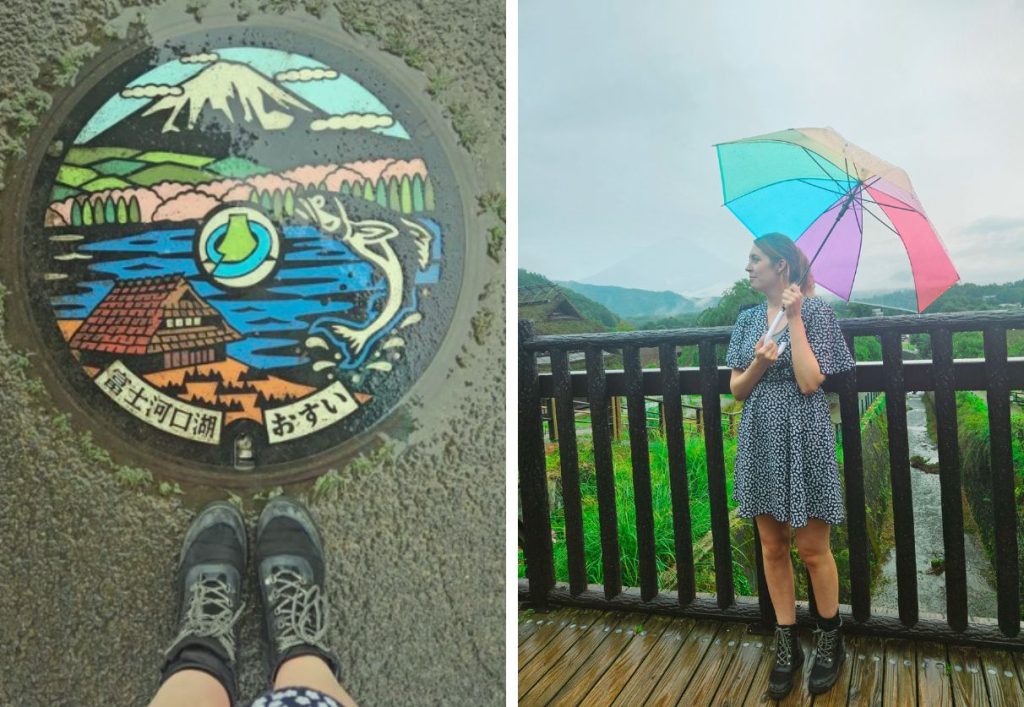
Activities & crafts
#8 – Charcoal-making hut
As the name suggests, you’ll be able to make your very own charcoal inside this building, which will allow you to learn the techniques used by many before you. This can be a useful skill and a fun way to spend some time in this rural village.
#12 – Hinomiya
This building in Saiko Iyashi no Sato Nemba is a mixture of both an activity spot and a museum. Here, you’ll find various types of ninja costumes, traditional kimonos and ancient pieces of armour for you to look at and appreciate. If you’d like to get fitted to try some on, you also have that option. It’s a way to really immerse yourself in the traditional clothing from Japan’s past while in this old-fashioned village.
#13 – To to Ko no Kayanuma
This is another activity spot where you can learn how to make incense. You’ll have a guide to walk you through all of the steps, and you’ll get to take home your own creation at the end. If you plan ahead, you can even reserve a spot for their pottery-making class in this same hut.
#14 – Glass & Metal Tupai Studio
This is one of my favourite properties in the village because you get to make your own kaleidoscope by hand or if you’d prefer, you can engrave some metal as a souvenir instead.
#16 – Fujisan Silk
One of the most popular activities in Saiko Iyashi no Sato Nemba is painting your own silk drawstring bag. If you’d rather not partake in a painting session, you can still purchase a pre-painted silk scarf made locally in Japan or look at other accessories for sale.
#17 – Tsuchiasobi Fuji Roman-gama
Another pottery-related building, here you can build your own small souvenirs from clay. This is a fun way to spend some time in the village, and you’ll get to take home anything you make!
#18 – Chirimen-zaiku & Tsurushi-kazari
In this building, you’ll get to create your very own traditional hanging dolls made entirely from cloth. These hanging dolls (known locally as tsurushi-bina) can be admired on the large display to give you an idea of what you can make, or they can be made by each visitor. As expected, you’ll be able to take whatever you make home as a souvenir.
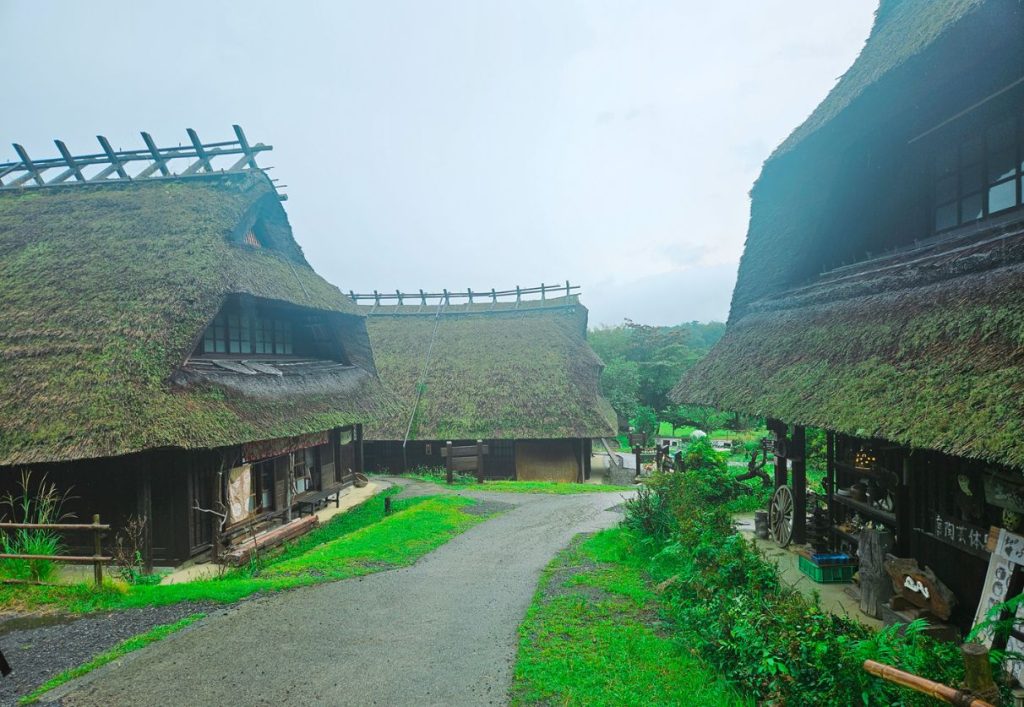
Opening Times & Admission Fees
Single entry cost:
| Ticket Type | Single Price | Group price (20+) |
|---|---|---|
| Adult (high school + up) | 500 JPY (2.60 GBP) | 450 JPY (2.37 GBP) |
| Adult (with disability badge) | 150 JPY (0.79 GBP) | – |
| Child (elementary | 250 JPY (1.32 GBP) | 200 JPY (1.05 GBP) |
| Child (with disability badge) | 50 JPY (0.26 GBP) | – |
Opening hours: The village is open 7 days a week and 365 days a year. The opening times for the village do depend on the season, however:
- Winter (December to February) – 9.30 am – 4.30 pm
- Summer (March to November) – 9 am – 5 pm
Accommodation & where to stay
Unfortunately, it is not possible to stay in Saiko Iyashi no Sato Nemba, so, if you need somewhere to stay after visiting (assuming you travel without a tour group) you’ll be pleased to know that you can stay in the same general region.
There are, fortunately, a few properties just a short walk away, or if you’re happy to consider a slight distance further, you have many more properties available.
Check out accommodation options for the following places:
Have you been to Saiko Iyashi no Sato Nemba Traditional village? What did you think?
Need help planning your trip?
Check out how to plan a trip abroad & see my travel resources for more.
Skyscanner – A comprehensive comparison website showing where to purchase flights.
HostelWorld – The biggest selection of hostels & sociable accommodations.
Booking.com – The largest collection of accommodations AND flights worldwide.
Safety Wing – A travel insurance brand for long-term travellers and nomads.
Airalo – An eSIM card company that lets you stay connected during your trip.
Wise – Perfect for transferring foreign currencies.
iVisa – For applying for tourist and visitor visas.
Viator – Great for finding tours and activities worldwide.
Get Your Guide – Another company for finding activities.
Klook – Have some of the best activity deals in Asia.

